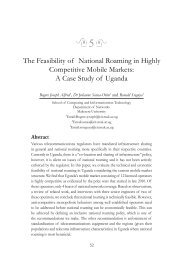Undergraduate Handbook - School of Computing and Informatics ...
Undergraduate Handbook - School of Computing and Informatics ...
Undergraduate Handbook - School of Computing and Informatics ...
You also want an ePaper? Increase the reach of your titles
YUMPU automatically turns print PDFs into web optimized ePapers that Google loves.
programming language Java; Gain experience in implementing object-oriented Programmes in Java; Apply an<br />
iterative, use case-driven process to the development <strong>of</strong> a robust design model; Use UML to represent the design<br />
model; Apply the OO concepts abstraction, encapsulation, inheritance, hierarchy, modularity, <strong>and</strong> polymorphism to<br />
the development <strong>of</strong> a robust design model; <strong>and</strong> Design <strong>and</strong> implement a s<strong>of</strong>tware system using object-oriented<br />
s<strong>of</strong>tware engineering paradigm.<br />
Indicative Content: In particular the course covers the following main themes <strong>and</strong> associated topics: Systems<br />
modeling <strong>and</strong> Design S<strong>of</strong>tware Engineering processes <strong>and</strong> principles <strong>of</strong> good s<strong>of</strong>tware design. UML modeling <strong>and</strong><br />
design with particular emphasis on s<strong>of</strong>tware architecture, behavioral modeling, object interactions <strong>and</strong> state-charts.<br />
Formal specifications <strong>of</strong> system requirements Principles <strong>of</strong> formal specifications <strong>and</strong> object orientation, state <strong>and</strong><br />
operation schemas; class schemas, object aggregation <strong>and</strong> inheritance; specification <strong>of</strong> dependency <strong>and</strong> information<br />
sharing; definition <strong>of</strong> class union; semantic issues; reasoning techniques for validating invariant properties, such as<br />
safety <strong>and</strong> liveness; Specification <strong>of</strong> object oriented Programmes Principles <strong>of</strong> object-oriented Programme<br />
specifications, concepts <strong>of</strong> mid-conditions, pre-conditions <strong>and</strong> post-conditions <strong>of</strong> methods, the role <strong>and</strong> definition <strong>of</strong><br />
class invariants; loop invariants as a programming technique; techniques for reasoning about the correctness <strong>of</strong><br />
Programmes. The development process Generation <strong>of</strong> specifications <strong>of</strong> object-oriented Programmes from formal<br />
specifications <strong>of</strong> system requirement; validation <strong>and</strong> verification processes <strong>of</strong> s<strong>of</strong>tware system; acquisition <strong>of</strong><br />
practical experience in modelling <strong>and</strong> specifying Java Programmes, using appropriate tools for developing <strong>and</strong><br />
checking specifications <strong>of</strong> Java Programmes.<br />
Reference Books:<br />
i. C. Larman, Applying UML <strong>and</strong> Patterns: An Introduction to Object-Oriented Analysis <strong>and</strong> Design <strong>and</strong> the<br />
Unified Process, 2nd edition, Prentice-Hall, 2002.<br />
ii. S. R. Schach, Object Oriented <strong>and</strong> Classical S<strong>of</strong>tware Engineering, 7th edition, McGraw-Hill, 2007.<br />
iii. R. S. Pressman <strong>and</strong> D. Ince, S<strong>of</strong>tware Engineering A Practitioners Approach, McGraw-Hill, 2007.<br />
iv. I. Sommerville, S<strong>of</strong>tware Engineering, 8th edition, Addison Wesley, 2006.<br />
v. R.H. Thayer, <strong>and</strong> M. J. Christiansen, S<strong>of</strong>tware Engineering, Volume 1: The Development Process, 3rd<br />
edition, Wiley & Sons, 2005.<br />
vi. R. H. Thayer <strong>and</strong> M. Dorfman, S<strong>of</strong>tware Engineering, Volume 2: The Supporting Processes, 3rd edition,<br />
Wiley & Sons, 2005.<br />
BSE 3107: Real-Time <strong>and</strong> Embedded Systems (4 CU)<br />
Course Description: At the end <strong>of</strong> the course students should be able to: Demonstrate knowledge <strong>of</strong> rate monotonic<br />
theory <strong>and</strong> how to apply it to real-time applications; Underst<strong>and</strong> the process <strong>and</strong> fundamentals <strong>of</strong> integrating<br />
microprocessor-based embedded system elements to realize systems that not only meet functional requirements, but<br />
timing <strong>and</strong> performance requirements as well; <strong>and</strong> Use practical skills to design <strong>and</strong> integrate a real-time operation<br />
system with a microprocessor to host real-time service data processing.<br />
Indicative Content: Rate Monotonic Theory, specifically the RM least upper bound, necessary <strong>and</strong> sufficient<br />
feasibility tests, <strong>and</strong> application <strong>of</strong> rate monotonic theory , Real-time Operating Systems, scheduling,<br />
synchronization mechanisms, <strong>and</strong> resource management, Embedded system architectures: System-on-chip, scalable<br />
bus architectures, memory subsystems, Sensor <strong>and</strong> Actuator IO: ADC, DAC, servos, relays, stepper motors, Hbridge,<br />
<strong>and</strong> CODECs, Real-time embedded test equipment, s<strong>of</strong>tware debug tools, <strong>and</strong> methods <strong>of</strong> performance<br />
pr<strong>of</strong>iling <strong>and</strong> tracing, Real-time applications including voice/packet-switched links <strong>and</strong> networks, streaming video<br />
media, computer vision, digital control, <strong>and</strong> robotic system comm<strong>and</strong> <strong>and</strong> control.<br />
Reference Books:<br />
i. M. Ben-Ari, Principles <strong>of</strong> Concurrent <strong>and</strong> Distributed Programming, Prentice Hall, 1990.<br />
ii. S. Bennett, Real-Time Computer Control: An Introduction Series in Systems <strong>and</strong> Control Engineering,<br />
International Prentice Hall, 1988.<br />
116

















